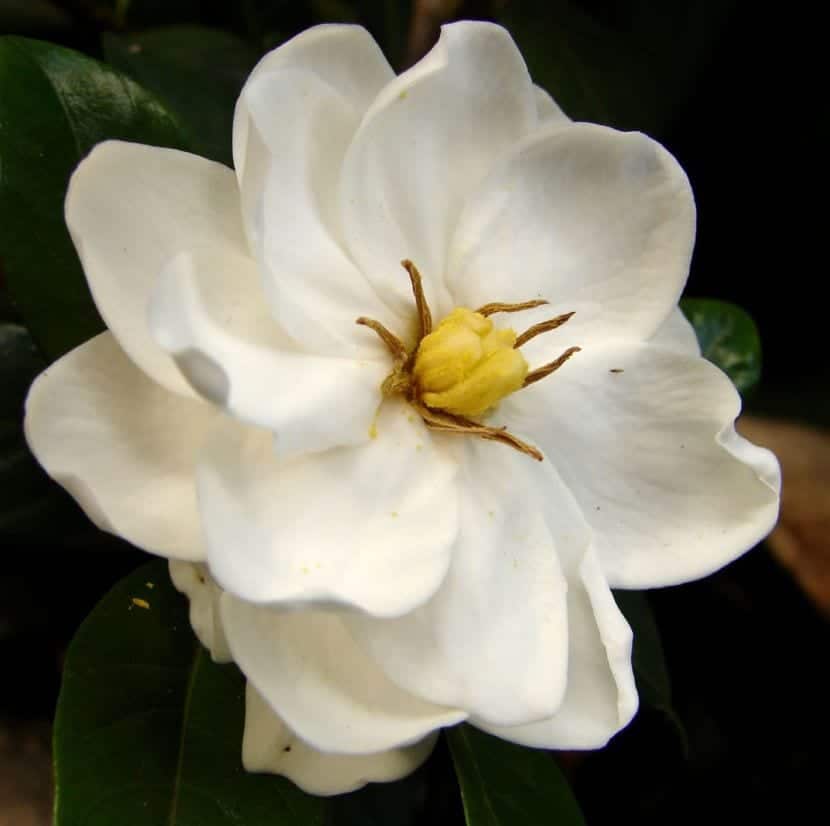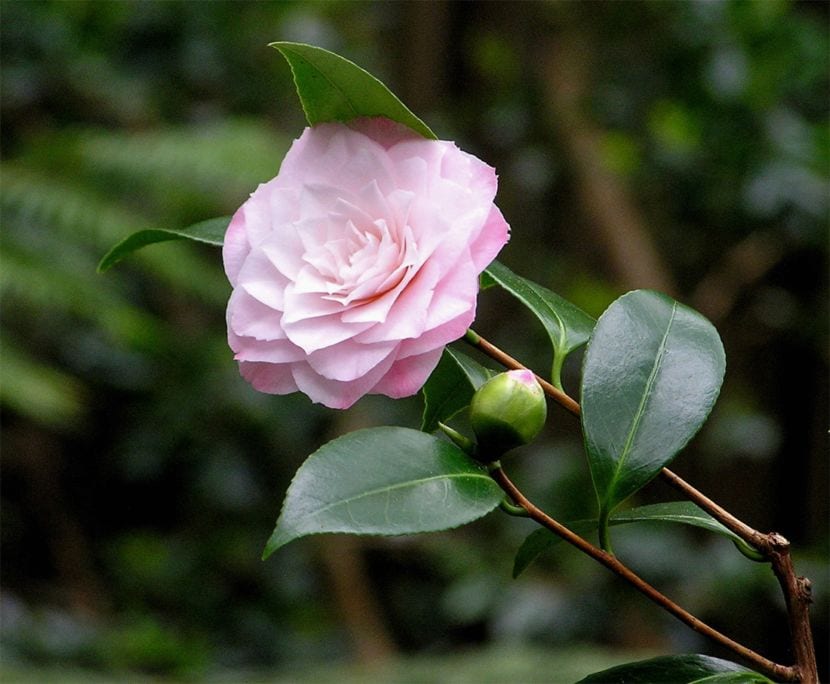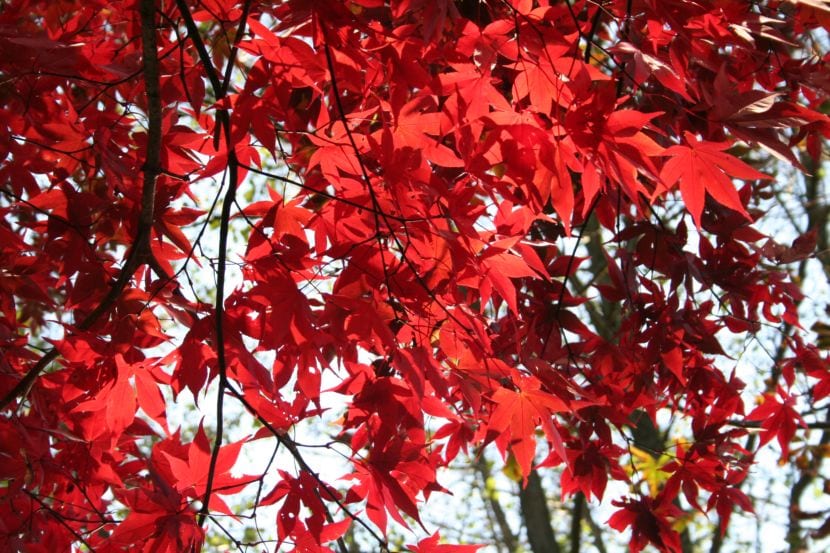
It is common to find in all nurseries and garden centers some trees and shrubs that are not typical of the place where we live. They are plants known as acidophilic, which originate mainly from Asia, specifically China and Japan. These plants live in acid soils, that is, with a pH between 4 and 6; and chlorosis appears in its leaves when that pH is higher. They also enjoy a climate whose seasons are well differentiated: with a rather warm-temperate summer and winter with some mild frosts; and whose rainfall is abundant, which makes the climate humid all year round.
If our climate is slightly different, these plants may have a hard time adapting. But don't worry: we'll give you a few tips to make things easier for your beloved plant.
But first, we will show you a list of them:
Acer palmatum

El Acer palmatum, better known as japanese mapleIt is one of those trees that you fall in love with as soon as you see it. Its webbed leaves, which turn red or orange in autumn, make this magnificent tree an exceptional choice to decorate any temperate garden around the world. In addition, it is widely used as bonsai, as it tolerates pruning very well.
Camelia

All the Camellias They are very beautiful. It is a shrub or small tree that does not like too dry or excessively hot summers. Its leaves are dark green, with serrated edges. The flowers can be pink, white, orange ... They are very similar to those of rose bushes, don't you think?
daphne smells

La daphne smells It is a shrub with long, lanceolate leaves with whitish leaf margins. Its small pink flowers composed of four petals, give off a pleasant aroma. It is suitable for potting.
Hydrangea

Hydrangeas are very popular plants. They grow as shrubs, the leaves of which are quite large, about 6-7cm long, mint green in color and with serrated edges. Its flowers are grouped in inflorescences in the shape of a »ball», forming a spectacular group.
Rhododendron and Azalea

They are plants whose flowers are beautiful, very elegant, which can be of different colors: pink, white, red, ... The main difference is that the leaves of the Azalea are rather small, while those of the Rhododendron are more elongated. Both tolerate a wide range of temperatures, but both extreme cold and heat do not like them.
Care
When the weather is good ...

If our climate is temperate throughout the year, growing these plants is relatively easy. The only thing we will have to find out is the pH of the soil that we have in the garden, and the pH of the irrigation water which must also be acidic.
The location may be in full sun if the summer is humid; Otherwise, it must be in half shade, or under taller trees whose shade will prevent the leaves of our acidophilic plants from being burned by the sun.
The subscriber is important to guarantee an optimal development of the plant. Specific fertilizers for acid plants are already available on the market. But if we want to fertilize with organic and ecological matter, we can use: worm castings, manure, compost, etc.
When the weather is not good ...

If our climate is very hot in summer, very dry, or very cold, we must take certain measures so that acidophilic plants can grow properly.
It is important to know that:
- The hot, dry summer wind will at least dry out the tips of the leaves. In severe cases, the leaves can dry out completely and fall, thus weakening the plant, which will hopefully arrive alive in autumn. But the leaves that are left will not change color.
Also, the intense sun can negatively affect the plant. - They need high humidity, both in the substrate and in the environment.
- Some trees, like maples, tolerate freezing temperatures, but not severe frosts.
- If we have a clay soil, we will not be able to plant them in the ground. They must remain in a pot.
- They need to feel the four seasons. If our climate is warm or cold all year round, they will not be able to survive.
That said, to help them we will do the following:
- We will not put them in full sun, except in spring and winter. In summer it is highly advisable to spray with distilled or rain water in the afternoons when the sun has lost its strength. Or place glasses of water around the pot.
- If there is a risk of intense frosts, we will protect them with a greenhouse or inside the home away from drafts and, above all, from heating. As soon as the risk has passed, we will have them abroad again.
- We can use a specific substrate for acidophilic plants, or we can make one using blond peat (60%), black peat (30%), and a little perlite.
- We will water frequently, especially in the hottest months. It is not necessary to leave the substrate waterlogged, but it is convenient that the substrate does not dry out completely.
- To acidify the water, we will add a few drops of lemon or vinegar to the irrigation water.
- Use specific fertilizers for acid plants, following the manufacturer's recommendations.
With these tips, you will see how your plants grow strong and healthy.
Thank you for your excellent comments ...
Thank you very much for sharing your knowledge on acidophilic plants; It has been very useful to me !
Thanks to you for following us 🙂
Thank you for sharing your knowledge, it is very important to be able to identify the type of plant we have in order to know how to handle it. I am fond of bonsai and I have 17-year-old specimens
Thanks for your words, Gonzalo 🙂
I have two pacifics and the yellow eyes come out, I made him his vitamins and I don't know what happens to him I water them every two or three days but nothing
Hello Amparo.
Have you checked if they have any insects on the back of the leaves? For prevention, I recommend giving them a universal insecticide treatment, and so we have this front covered.
As for the fertilizer, how often do you pay it? It is important to follow the manufacturer's recommendations to avoid overdose if fertilized with chemicals.
And finally, the irrigation, water them less, once a week or two at the most. In summer you have to water more, every 2-3 days, but the rest of the year it is better not to water more than 1 or 2 times in seven days.
A greeting.
Hi Monica… I have a question: do you think that humus and mulch is a fairly acidic substrate for a geranium or slightly acidophilic plants? I have also read that some fertilizers can raise the pH ... in particular I do not know if the ammonia-based or the calcium-based ... do you have any experience in this regard?
By the way, you put black peat twice… Congratulations on the blog
Hi Juliana.
Geraniums are not picky about the soil or the substrate. I can tell you that many times I have seen them planted in limestone soil, and growing without problems.
Slightly acidophilic plants need a low pH, between 5 and 6. The earthworm humus has a pH of 6,5 - 7. It can go well as long as it is fertilized with fertilizers for this type of plants.
Greetings and thanks for the notice and for your words 🙂
Monica, ¨a cido.¨..a pleasure to read you..I am going to point out your wisdom… .thanks Javier…
Why do the hydrangea leaves turn yellow and discolored ??? Thank you very much for all the contribution you give me, Manoli
Hello Manoli.
What type of water do you water it with? And how often? I tell you:
-If you see the nerves of the leaves, it is because it has chlorosis, caused by the lime in the water. In this case, I recommend watering with water to which the liquid of half a lemon has been added, and also fertilize the plant with fertilizers for acidophilic plants in spring and summer.
-If the leaves turn yellow, it is usually due to excessive watering.
-If it is only the lower leaves that turn yellow, it is completely natural as long as they come out new. Otherwise it is because the irrigation frequency is not adequate.
Hydrangeas have to be watered 3-4 times a week in summer, and 2 a week the rest of the year.
Greetings 🙂.
Thank you very much for your quick reply, I will follow your advice and see what happens… .Manoli
Let's see how it goes. Greetings 🙂
Hello Monica, how good it is that you allow us to participate in your blog since so many of us learn from your knowledge and experience. Here I ask you a question, the iron chelate is a dark powder that when dissolved in water colors it red? I ask you this question because I bought this product to apply to bougainvillea, hortencias, photos, etc, with only the seller's statement that it was an iron chelate and when I did the test with a little bit of the «iron chelate», he dyed the water Red. Is that so?
Hi Edwin.
Yes it's normal. Do not worry.
By the way, we are all students and teachers at the same time 😉. But thanks for your words.
A greeting.
I want to know everything about acidophilic plants
Hi Monica, I live in Lima, where we have a temperate climate. I have several potted plants and I don't know which ones to add regular fertilizer to and which ones to add acidic fertilizer. Let's see if you can help me. I have: kalanchoes, bougainvillea, geraniums and gerberas. Thanks a lot !
Hello Sandra.
Of the plants you mention, only bougainvilleas and gerberas can do well with an occasional fertilizer with acidic fertilizers. But it is not really necessary.
This type of fertilizer is used for plants such as Japanese maples, camellias, gardenias or hydrangeas. The rest can be paid with a universal fertilizer, or organic without problem.
A greeting.
Hi Monica, I am planting Gloxinis in Lima, and Begonias, what type of fertilizer do you recommend and should the soil be acidic? What advice can you give me so that they have good growth?
Thanks for your answer
Exitos
Hi Daysi.
You can fertilize them with any fertilizer for flowering plants (they are already prepared).
As a substrate you can use the normal universal crop, or mulch with 30% expanded clay balls or river sand.
Greetings and thank you.
In the initial list indicating acidophilic plants, among others, it was necessary to mention the magnificent ornamental Magnolia liliiflora as such.
To each one of those who make up Jardinería OnThank you for everything you give us every day. Atte.
Edmond, from Los Antiguos, Santa Cruz, Argentina
Hi Edmond.
Thank you very much for your comment. 🙂
Indeed, Magnolias are acidophilic, and liliiflora is, as you say, very very pretty.
A greeting.
Excellent and congratulations for making contributions with your knowledge!
I have a place with trees in the south of Chile (not the extreme) where it rains a lot and the summer is short, the soil is spongy with so many leaves that for years they have accumulated, Canelo, Gualles, Avellanos and some ulmos ... in end. my question is if that spongy soil is Humus? And how should I take advantage of it to get some benefit from it, ... I can mix it with other soil or with sand to make a greenhouse or a vegetable garden, would it help me ???
I would like to know your opinion I would appreciate it very much ¡¡atte Miguel
Hi miguel.
I prefer more because it is peat. Still, it is a good soil for plants. You can use it alone or mixed with sand.
A greeting.
Good afternoon!
I wanted an advice on which medicinal and / or aromatic plants I can plant in a field of about 5000m2 but with a strong Ph4,85. Land with little water and lots of sun.
Thanks a lot.
Julia
Hello Julia.
Sorry, I can't think of any. These types of plants need a soil with a pH of at least 6, since if it is lower they will lack essential nutrients (such as calcium). Therefore, if you want to have some, I would recommend you first. put lime to the ground.
A greeting.
Thank you very much, I have a ficus in an ideal interior patio for plants but I did not know how to fertilize it and it had not occurred to me that it was acidophilic like my hydrangeas, your advice has been very useful.
Hello Silvia.
Ficus grow in almost any type of soil; except ficus carica which only does so in clay soils.
Thank you for your words! 🙂